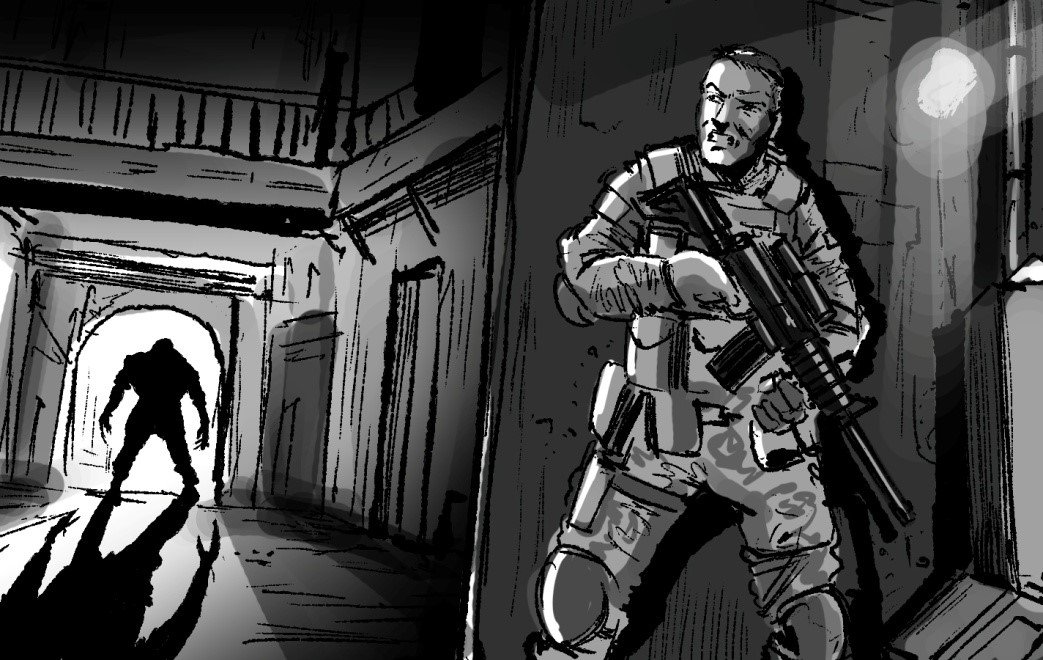
Throughout the history of filmmaking, storyboarding has been used to pre-visualize films and help with production. Here I propose a new film visualization tool to complement storyboarding, which I call ‘Storyboardgraphy’ and define as a ‘film pre- and post-visualization tool showing shot sizes and lengths along a timeline’. A storyboardgraphic consists of two axes, with the X-axis representing the scene timeline, the Y-axis the size of the shots, and the characters depicted as recognisable curves. Storyboardgraphy is an excellent way of visualising
a) shot sizes/lengths in a simple graphic.
b) shot pacing (changes in the lengths of shots over the film timeline).
c) the dynamic of shot sizes (the order of shots along the scene timeline), which are not easily perceived on a conventional storyboard. Therefore storyboardgraphy is of huge interest, not only for pre-visualisation and production, but also for post-visualisation when editing, teaching film-making and studying film.
INTRODUCTION
A storyboard consists of illustrations or images presented in a sequence that act as a tool for pre-visualising a motion picture (Glebas Citation2008; Pallant and Price Citation2015). Storyboards are not only used in film but also in the theatre, novels, comic books, animations, photometric, business and architectural studios, interactive media, software and scientific studies. The storyboarding concept, as we know it today, was developed by Walt Disney Productions during the early 1930s (Miller Citation1957).
A film storyboard helps film directors and cinematographers visualise scenes and predict whether or not they can convey the intended information and emotion of the film to the audience. They are also used to detect potential creative or production problems before they occur, to save producers’ time, and to estimate the overall cost of the production.
Storyboards are a very powerful tools for pre-visualising a film and planning its shots but in some cases are too long and complex, and the overview of the whole scene is lost. Another limitation of a storyboard is that it does not intuitively visualise the pacing of the shots (changes in the lengths of the shots over the film timeline) or the dynamic of shot sizes (the order of the shots on the scene timeline). Both shot pacing and size dynamics affect how audiences perceive information and react emotionally to a film. To overcome these limitations, I present here a complementary tool, which I call ‘Storyboardgraphy’.
STORYBOARDGRAPHY
I define storyboardgraphy as ‘a film pre- and post-visualization tool showing shot sizes and lengths over a film timeline’. A storyboardgraphic consists of two axes, the X-axis representing the scene timeline and the Y-axis the sizes of the shots; the different characters in the film are recognisable by the colour, size and shape of the curves; shots are numbered as S1, S2 … etc. (Figure 1). The X-axis can use seconds or frames as units. For the shot sizes on the Y-axis, I use the classification of shot sizes defined by Katz (Citation1991); Extreme Close-up, Medium Close-up, Full Close-up, Wide Close-up, Close Shot, Medium Close Shot, Medium Shot, Medium Full Shot, Full Shot, Wide Shot, and Extreme Wide Shot. The distances between Extreme Close-up and Full Shot are scaled relatively, while the distances between Full Shot and Extreme Wide Shot are simply indicative and reduce the size of the Y-axis. This can be adjusted to satisfy the needs of the scene and the workspace preferences of the ‘storyboardgrapher’.
Storyboardgraphy has some limitations:
1) storyboardgraphy is difficult to apply for scenes with special framing.
2) the reading of a storyboardgraphy could be confusing when many characters are involved in the scene.
3) some details such as camera height and angle, and the exact positions of the characters in the scene are not shown in the storyboardgraphy. Nevertheless, storyboardgraphy is not designed to replace the use of a storyboard but rather to complement and facilitate it and, despite these limitations, is an extremely useful tool if properly employed.
Share This News